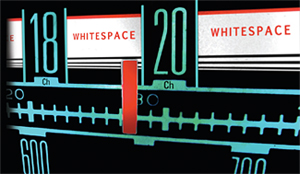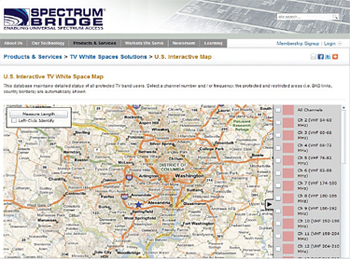Resistance Lessens to White Spaces

WASHINGTON
The FCC's Opinion & Order in late September on white spaces was greeted mostly with silence from parties heretofore highly critical of the proposal. The sounds of silence from broadcast groups that have opposed the notion of tapping into the mostly unused spectrum situated between broadcast channels by unlicensed consumer devices may be partly due to a pending lawsuit. But the commission's latest action also may have alleviated some of the key concerns of the so-called "super Wi-Fi" proposal.
White spaces supporters, for their part, were not so quiet. Liam Quinn, chief technology officer for Dell client products, said "opening [white spaces] will unleash a whole new class of mobile wireless broadband services with applications that are nearly limitless." The Dell exec said in addition to providing Americans with greater online access, "I think TV white spaces will enable seamless streaming of content among devices around the home and provide greater broadband reach to businesses and schools in rural areas. It will enable large-scale 'hot spots.'"
Audio-Technica, which manufactures wireless microphones, among the items most impacted by the FCC's decision, also applauded the commission's actions. "Many of our wireless systems are designed to work well when numerous simultaneous channels are needed, or when used in channels adjacent to TV," the company said in a statement.
'SIGNIFICANT MODIFICATIONS'
NAB, on the other hand, at press time (Oct. 4) was still holding its tongue on the Sept. 23 ruling. Dennis Wharton, NAB's chief spokesman, told TV Technology "we [still] have a pending court challenge based on 'arbitrary and capricious' findings by the FCC. That lawsuit continues, and is pending in the U.S. Court of Appeals for the DC Circuit." The litigation was held in abeyance pending FCC action. Now that the FCC has acted, the white spaces litigation is again proceeding.
The Association for Maximum Service Television, a co-party with NAB in the court challenge, also begged off commenting on the FCC's latest white spaces action. MSTV had been highly critical of certain aspects of the issue—especially the wireless mic question—but the association has uncharacteristically refrained from reiterating its position two weeks after the FCC ruling.
Still, NAB has advised its engineers/members that the latest FCC order "makes a number of significant modifications to the [original] 2008 rules." NAB's Science & Technology Department writes that one "significant change" in the new rules is the elimination of the requirement that TV band devices (TVBD) employ spectrum-sensing technology for the presence of a broadcast station, LPTV, or wireless mic. NAB tells its members "the new rules do include a provision for a sensing-only TVBD, but they will be subject to rigorous testing by the FCC lab before they can be put on the market."
The new rules also call for geo-locations (where arrays of wireless mics are used on a fairly regular basis) to be registered in databases and, therefore, at least theoretically protected from interference. By early October, at least nine companies had submitted proposals to the FCC to manage these databases, including Google (see below).
On the controversial wireless mics issue, NAB advises its members that the new rules "significantly change protections" for licensed and unlicensed wireless microphones. In its September order, the FCC called for reserving two vacant UHF channels for wireless licensed and unlicensed mics in all regions of the United States. These include the first channel above and first chanel below ch. 37 (608–614 MHz) not already occupied by an authorized service. If neither channel is readily available, then the first two channels nearest to ch. 37 are in play.

Chris Lyons'VOTE OF CONFIDENCE'
Chris Lyons, Shure's manager of technical & educational communications, said the FCC's latest order is "a definite vote of confidence from the FCC to wireless mic users. All through this proceeding, the challenge for us has been to let the FCC see exactly how important wireless mics are, and how many kinds of users are dependent on them. They got that. Wireless has been a very large part, and remains one of the fastest-growing segments of our business, for years. That's amazing when you consider the typical wireless device costs 5-10 times more than wired," Lyons said.
"What's going to be more complicated now is that [new white spaces] devices will be much more sporadic in their transmissions, and much more mobile, and carried by a lot more people, so it does make the interference potential more complicated," Lyons said. "But the [FCC] idea of setting aside those two channels free of those devices is a fantastic solution."
Bill Kish, founder of Ruckus Wireless—which sometimes refers to white spaces as "white-Fi"—thinks a key advantage of using additional spectrum is the low frequency in which it operates and the low-power radios needed to access it. "Depending on the location, white spaces are available between 50 and 800 MHz [although not within a contiguous frequency band everywhere], which is far lower and will deliver much greater range than the standard Wi-Fi frequencies of 2.4 and 5 GHz," Kish said. "This makes it ideal for rural environments where distance and coverage is everything—and where deploying a macrocell 3G network in these areas is cost-prohibitive."
Kish said low-frequency signals also should provide better penetration through walls and within buildings (a frequent gripe with current Wi-Fi). But he cautions that white spaces is limited by its channel width. "Each white spaces channel is only 6 MHz wide, with a maximum theoretical data rate of around 40 Mbps. And each channel is shared among potentially thousands of users within a large range, given the distance that low frequency signals travel. Compare this to 802.11n Wi-Fi which supports 20- and 40-Mhz wide channels and multiple spatial streams capable of delivering 450 Mbps or more. The emerging 802.3ac standard is looking to extend this even further…" Kish said.
A lingering concern, Kish added, will be the number of white-space channels in the largest markets—i.e., New York City, Los Angeles, Chicago and Philadelphia—which he said will be extremely limited. "Remember that unlicensed spectrum is just that… unlicensed. This means anyone can use it anytime for anything. As a result, interference will remain an issue," Kish said. "New 'smart antenna' arrays with the ability to constantly survey the radio environment to select the best signal path at any given time will add significant value to making these wireless networks much more reliable."
Comment on this or any story. Write totvtech@nbmedia.comwith “Letter to the Editor” in the subject line.
Companies Vie for White Space Database ManagementWASHINGTON
Nine companies have submitted proposals to the FCC to manage white space databases for TVBDs. The devices will have to reference the databases to locate open and occupied spectrum:
Mountain View, Calif.-based Google is the largest of the nine to submit a proposal. It was one of the main proponents behind opening TV airwaves up to unlicensed devices.
Comsearch of Ashburn, Va., already works with several federal agencies on developing rules and standards for the use of radio frequency spectrum. The company currently manages a spectrum database in the 70-90 GHz band as well as one tracking wireless medical telemetry services. It submitted a 55-page proposal to the FCC.
Spectrum Bridge is among the nine companies competing to manage white space databases for TVBDsNeustar of Sterling, Va., threw in to be a database manager. The company’s proposal notes that it currently manages the database for cell-phone number portability. In addition to databases serving wireless carriers, Neustar administers the .us and .biz domain registries.
Another Virginia tech corridor company, Key Bridge Global LLC of McLean, said it is only applicant to bring in technology from other companies. Key Bridge’s proposal listed Sun and Oracle hardware, Amazon’s cloud computing resources, Level 3’s infrastructure as well as contributions from Java, Linux, Google and Paypal, among others.
KB Enterprises, a Washington, D.C. consultancy, and LS Telcom of Lichtenau, Germany, submitted a joint proposal. KB’s founder developed the FCC’s Universal Licensing System, and LS creates spectrum-management software used by militaries, governments and private-sector regulators.
Frequency Finder of Toccoa, Ga., and RadioSoft of Edgewater, Fla., jointly applied to be database managers. Their proposal says RadioSoft has been processing FCC databases since 1981, and has “supplied third-party FCC data queries online since 1987.”
WSdB LLC was formed just to manage a white space database. Neither its filings nor its home page indicate location headquarters, though its initial investor is based in Dallas. It proposes to create an application programming interface to enable real-time synchronization with other databases.
Spectrum Bridge of Lake Mary, Fla., is a contender. The company has helped launch local white space Wi-Fi systems in Claudeville, Va.; Wilmington, N.C.; Plumas County, Calif.; and Lake Mary.
Finally, Telecordia Technologies of Piscataway, N.J., is vying to run a white space database. Telecordia primarily makes software for telecom providers. Its proposal says the company has provided “engineering, economics and legal support direct to 40 spectrum regulators and 25 wireless network operators” over a quarter century.
- Deborah D. McAdams

The professional video industry's #1 source for news, trends and product and tech information. Sign up below.
